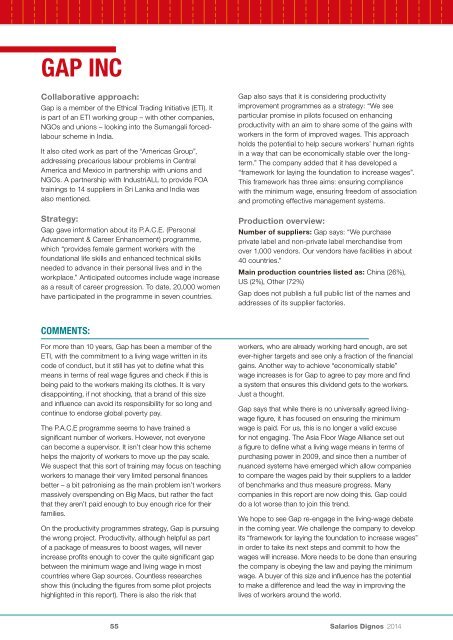17Investigación SALARIOS dignos definitiva
17Investigación SALARIOS dignos definitiva
17Investigación SALARIOS dignos definitiva
You also want an ePaper? Increase the reach of your titles
YUMPU automatically turns print PDFs into web optimized ePapers that Google loves.
GAP INC<br />
Collaborative approach:<br />
Gap is a member of the Ethical Trading Initiative (ETI). It<br />
is part of an ETI working group – with other companies,<br />
NGOs and unions – looking into the Sumangali forcedlabour<br />
scheme in India.<br />
It also cited work as part of the “Americas Group”,<br />
addressing precarious labour problems in Central<br />
America and Mexico in partnership with unions and<br />
NGOs. A partnership with IndustriALL to provide FOA<br />
trainings to 14 suppliers in Sri Lanka and India was<br />
also mentioned.<br />
Strategy:<br />
Gap gave information about its P.A.C.E. (Personal<br />
Advancement & Career Enhancement) programme,<br />
which “provides female garment workers with the<br />
foundational life skills and enhanced technical skills<br />
needed to advance in their personal lives and in the<br />
workplace.” Anticipated outcomes include wage increase<br />
as a result of career progression. To date, 20,000 women<br />
have participated in the programme in seven countries.<br />
Gap also says that it is considering productivity<br />
improvement programmes as a strategy: “We see<br />
particular promise in pilots focused on enhancing<br />
productivity with an aim to share some of the gains with<br />
workers in the form of improved wages. This approach<br />
holds the potential to help secure workers’ human rights<br />
in a way that can be economically stable over the longterm.”<br />
The company added that it has developed a<br />
“framework for laying the foundation to increase wages”.<br />
This framework has three aims: ensuring compliance<br />
with the minimum wage, ensuring freedom of association<br />
and promoting effective management systems.<br />
Production overview:<br />
Number of suppliers: Gap says: “We purchase<br />
private label and non-private label merchandise from<br />
over 1,000 vendors. Our vendors have facilities in about<br />
40 countries.”<br />
Main production countries listed as: China (26%),<br />
US (2%), Other (72%)<br />
Gap does not publish a full public list of the names and<br />
addresses of its supplier factories.<br />
COMMENTS:<br />
For more than 10 years, Gap has been a member of the<br />
ETI, with the commitment to a living wage written in its<br />
code of conduct, but it still has yet to define what this<br />
means in terms of real wage figures and check if this is<br />
being paid to the workers making its clothes. It is very<br />
disappointing, if not shocking, that a brand of this size<br />
and influence can avoid its responsibility for so long and<br />
continue to endorse global poverty pay.<br />
The P.A.C.E programme seems to have trained a<br />
significant number of workers. However, not everyone<br />
can become a supervisor. It isn’t clear how this scheme<br />
helps the majority of workers to move up the pay scale.<br />
We suspect that this sort of training may focus on teaching<br />
workers to manage their very limited personal finances<br />
better – a bit patronising as the main problem isn’t workers<br />
massively overspending on Big Macs, but rather the fact<br />
that they aren’t paid enough to buy enough rice for their<br />
families.<br />
On the productivity programmes strategy, Gap is pursuing<br />
the wrong project. Productivity, although helpful as part<br />
of a package of measures to boost wages, will never<br />
increase profits enough to cover the quite significant gap<br />
between the minimum wage and living wage in most<br />
countries where Gap sources. Countless researches<br />
show this (including the figures from some pilot projects<br />
highlighted in this report). There is also the risk that<br />
workers, who are already working hard enough, are set<br />
ever-higher targets and see only a fraction of the financial<br />
gains. Another way to achieve “economically stable”<br />
wage increases is for Gap to agree to pay more and find<br />
a system that ensures this dividend gets to the workers.<br />
Just a thought.<br />
Gap says that while there is no universally agreed livingwage<br />
figure, it has focused on ensuring the minimum<br />
wage is paid. For us, this is no longer a valid excuse<br />
for not engaging. The Asia Floor Wage Alliance set out<br />
a figure to define what a living wage means in terms of<br />
purchasing power in 2009, and since then a number of<br />
nuanced systems have emerged which allow companies<br />
to compare the wages paid by their suppliers to a ladder<br />
of benchmarks and thus measure progress. Many<br />
companies in this report are now doing this. Gap could<br />
do a lot worse than to join this trend.<br />
We hope to see Gap re-engage in the living-wage debate<br />
in the coming year. We challenge the company to develop<br />
its “framework for laying the foundation to increase wages”<br />
in order to take its next steps and commit to how the<br />
wages will increase. More needs to be done than ensuring<br />
the company is obeying the law and paying the minimum<br />
wage. A buyer of this size and influence has the potential<br />
to make a difference and lead the way in improving the<br />
lives of workers around the world.<br />
55<br />
Salarios Dignos 2014


